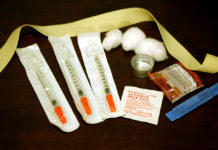According to the National Center for PTSD, a branch of the U.S. Department of Veterans Affairs (VA), 27 percent of veterans diagnosed with post-traumatic stress disorder (PTSD) also suffer from substance use disorder (SUD).
“We need to understand that this is an epidemic,” said Dr. Ricardo Restrepo, substance abuse treatment program and clinic medical director at the U.S. Department of Veterans Affairs. “We, as physicians, need to be cautious and careful on how we are prescribing and for how long we are prescribing [opioids].”
Veterans coming back from the Middle East face a 60 percent chance of returning with chronic pain, according to VA officials. Additionally, 50 percent of older veterans in the VA health care suffer from some kind of chronic pain.
Many returning veterans have long struggled with PTSD, and self-medicate with substances like alcohol and marijuana have been common — but opioids are now affecting veteran communities fighting to rebuild their lives after returning home from war.
Assimilating back into society is already difficult for veterans dealing with PTSD, and with opioid addiction reaching epidemic levels, they face riskier situations.
“The pharmaceutical companies played a major role in pushing for this kind of opioid treatment, which initially, we thought that we were doing our best,” Dr. Restrepo said. “Of course 20 years later, we are seeing the consequences.”
Additionally, 21 percent of veterans in substance abuse treatment were homeless, according to the Treatment Episode Data Set (TEDS) released by Substance Abuse and Mental Health Services Administration.
PTSD, SUD and “avoidance”
Using drugs and alcohol allows veterans to continue a cycle of “avoidance” found in PTSD, according to the VA.
Avoiding people, places, or bad memories can actually extend the effects of… (continue reading)
















